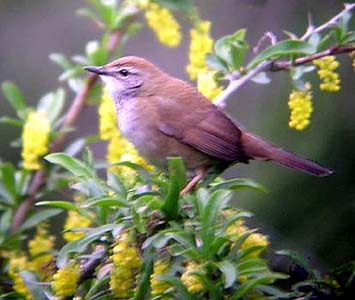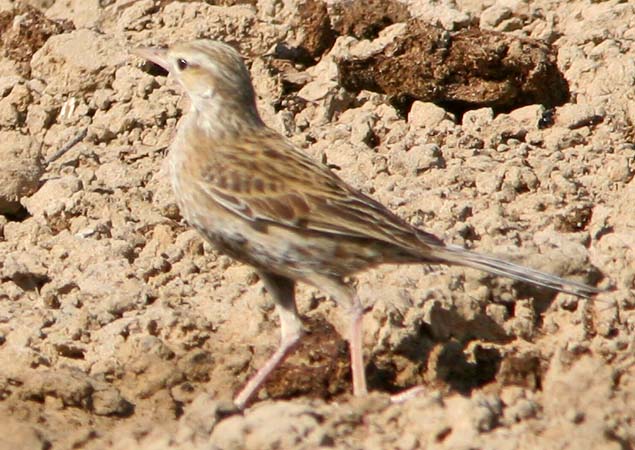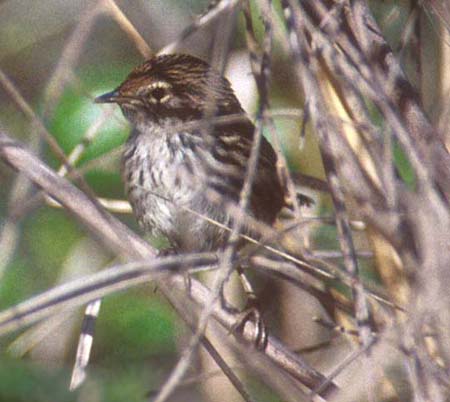
a web page by Don Roberson |
GRASSBIRDS Locustellidae |
|
The prior biochemical evidence showed that Grassbirds were a sister group to the Malagasy Warblers and together they are a sister group to the Acrocephalid Warblers (Jønsson & Fjeldså 2006), but the parameters of this new family has been poorly known (Alström et al. 2006, Jønsson & Fjeldså 2006, Barker et al. 2004). The new study (Alström et al. 2011) sampled 37 species in 7 genera and found that much of the previous generic arrangements were wrong. Their research led to a new family tree and many generic changes, although some issues remain unsettled. The family includes birds previously assigned to genera Megalurus [various grassbirds and thicketbirds], Bradypterus [bush-warblers], Locustella [grasshopper-warblers], Cincloramphus [songlarks], and Schoenicola [fan-tailed warblers], and few other genera assigned to the Megalurid 'subfamily' by Sibley & Monroe (1990) and Dickinson (2003). |
The Locustella bush-warblers and grasshopper-warblers are very secretive and most best located by vocalizations. They include some famed skulkers, such as Friendly Bush-Warbler L. accentor, found at very high elevation on Mt. Kinabalu and other north Borneo peaks. And some, like Benguet Bush-Warbler L. seebohmi of northern Luzon, Philippines, have a very soft and nearly inaudible song, making it exceptionally difficult to locate. The new DNA evidence has also led to the splitting of several species. Indeed, the "Spotted Bush-Warbler" of Dickinson (2003), for example, is now three species: Spotted Bush-Warbler L. thoracicus, Siberian (or Baikal) Bush-Warbler L. davidi, and West Himalayan Bush Warbler L. kashmirensis; Alström et al. (2008). Further, Taiwan Bush-Warbler L. alishanensis was only discovered as a cryptic species recently; Rasmussen et al. (2000). |
Unlike Spinifexbird, which looks and acts like a Megalurus grassbird, the songlarks are not typical megalurid skulkers, but rather ground-loving songsters. In winter the male Brown Songlark (left) is dull and recalls a big-billed, strong-legged pipit, but the pale tips to the feathers wear off in summer, turning the underparts a dark sooty-brown color. You can see that color already appearing on the lower breast in this November photo (spring 'down-under'). Males then sing from song posts or, most vigorously, in display flights. Another group of grassbirds that indulge in song flights are the two species of Schoenicola grassbirds, one in Africa (S. brevirostris) and one in India (S. platyura). |
I keep mentioning the grassbirds are mostly hard-to-see skulkers. An example that Spotted Bush-Warbler of the mountains of central Asia, whose photo is above. On a China trip we had one walking about just inches from our shoes in thick scrub one morning, but of then ten of us, only one caught a glimpse of it. Then, two days later, we worked with tapes for another hour before he popped up for quick views. Yet, the next morning, this male (left) decided to sit atop a flowering bush and sing for ten minutes straight! Truly inexplicable. It also took several days at multiple locales to call up a White-winged Warbler Bradypterus carpalis from papyrus swamp habitat in Uganda. But one that made even more of an impression on me was Dja River Scrub-Warbler Bradypterus grandis in Gabon. It was once known only from a few specimens near the Dja River in Cameroon, and totally unknown in the wild. Shortly before my trip to equatorial Africa in 1996, Patrice Christy found a small population in a Rhynchospora marsh in La Lopé Reserve, Gabon, and he showed us its display flight there in July 1996. It took repeated playing of its song to get quick glimpses in dense aquatic vegetation, but in due time it took up some display flights on its own, bursting into the air from a song-filled glide down into the marsh. We were the first American birders to enjoy this treat. Special.... The various Locustella warblers of northern Eurasia are also extreme skulkers. Lanceolated Warbler L lanceolata has a wide range in eastern Asia, and migrates to south Asia (indeed, a vagrant has reached California!), but is well known for behaving like a mouse. Cibois et al. (2001) point out that the large corvoid radiation in Australasia had been hidden by convergence for centuries and was only discovered through the biochemical DNA-DNA studies of Sibley & Ahlquist (1990) and progeny. It is exciting to learn that other radiations — this time of sylvioid warblers — have been hidden by convergence. A 'Malagasy clade' of at least 9 million years old has only recently been identified (Cibois et al. 1999, 2001, Barker et al. 2004). The Megalurids represent yet another 'hidden' assemblage just now being discovered through genetic research. And there are still problems to be sorted out, including the exact taxonomic position of Striated Grassbird, and a variety of potential cryptic species yet to be split; Alström et al. (2011). |
Photos: The Striated Grassbird Megalurus palustris was singing from riverine scrub on Mindoro I., the Philippines, on 7 Dec 2005. The Spotted Bush-Warbler Locustella thoracicus was at 8000' elevation in Huzu Bei Shan Nat'l Park, Qinghai Province, China, in June 2004. The Brown Songlark Megalurus cruralis was along the Birdsville Track, South Australia, in Nov 2009. The Fernbird Megalurus punctatus was in a marsh at the edge of Lake Taupo, North Island, New Zealand, in Dec 1997. All photos © Don Roberson; all rights reserved. Bibliographic note: There is no "family book" per se, but the Handbook of the Birds of the World series covered the species now assigned to the Locustellidae in Bairlein (2006). Literature cited:
|
 Together
there are just over 50 species in about a dozen genera, but DNA results
are not known from some of these. But about two-thirds of the family
was intensely sampled by Alström et al. (2011), and they propose
some major generic changes. Formerly, the genus Bradypterus included skulkers in both Africa and the Orient. Now, Bradypterus is restricted to the African species. All the Asian "Bradypterus" are now merged into genus Locustella, as the Japanese Swamp-Warbler "Megalurus" pryeri. Thus the Spotted Bush-Warbler of China (right) is now in genus Locustella. Indeed, that genus is now expanded by a dozen species.
Together
there are just over 50 species in about a dozen genera, but DNA results
are not known from some of these. But about two-thirds of the family
was intensely sampled by Alström et al. (2011), and they propose
some major generic changes. Formerly, the genus Bradypterus included skulkers in both Africa and the Orient. Now, Bradypterus is restricted to the African species. All the Asian "Bradypterus" are now merged into genus Locustella, as the Japanese Swamp-Warbler "Megalurus" pryeri. Thus the Spotted Bush-Warbler of China (right) is now in genus Locustella. Indeed, that genus is now expanded by a dozen species.  Another surprise in Alström et al. (2011) is that the two songlarks of Australia [former genus Cincloramphus] are embedded with genus Megalurus. So is the Spinifexbird "Eremiornis" carteri of the arid Australian interior.
Another surprise in Alström et al. (2011) is that the two songlarks of Australia [former genus Cincloramphus] are embedded with genus Megalurus. So is the Spinifexbird "Eremiornis" carteri of the arid Australian interior.  DNA
work has not yet been undertaken on various grassbirds in the south
Pacific, such as Buff-banded Grassbird in the monotypic genus Buettikoferella on Timor, the elusive Megalurulus mariei on New Caledonia (hinted to be extinct until recently), and thicketbirds on Fiji (Long-legged Thicketbird Megalurulus rubiginosus)
and two on New Britain and the Solomons (Melanesian and Rusty
Thicketbirds). I think all of them are serious skulkers.. It is assumed
for now that these are, indeed, grassbirds. The Alström et al.
(2011) study did prove that a Megalurus grassbird reached New
Zealand. This is Fernbird (right). It is the only sylvioid warbler to
reach New Zealand; the two other "warblers" are gerygones in the
unrelated Australasian Warbler family [Acanthizidae]. Fernbirds are
secretive but inquisitive birds of swamps and scrub, widely distributed
on the main New Zealand islands. They are most often found by the
metallic uu-tick calls; a mechanical double-call duet is
given by mated pairs (Heather & Robertson 1996). I was able to get
this shot when one responded to a rather poor tape-recording I had
available.
DNA
work has not yet been undertaken on various grassbirds in the south
Pacific, such as Buff-banded Grassbird in the monotypic genus Buettikoferella on Timor, the elusive Megalurulus mariei on New Caledonia (hinted to be extinct until recently), and thicketbirds on Fiji (Long-legged Thicketbird Megalurulus rubiginosus)
and two on New Britain and the Solomons (Melanesian and Rusty
Thicketbirds). I think all of them are serious skulkers.. It is assumed
for now that these are, indeed, grassbirds. The Alström et al.
(2011) study did prove that a Megalurus grassbird reached New
Zealand. This is Fernbird (right). It is the only sylvioid warbler to
reach New Zealand; the two other "warblers" are gerygones in the
unrelated Australasian Warbler family [Acanthizidae]. Fernbirds are
secretive but inquisitive birds of swamps and scrub, widely distributed
on the main New Zealand islands. They are most often found by the
metallic uu-tick calls; a mechanical double-call duet is
given by mated pairs (Heather & Robertson 1996). I was able to get
this shot when one responded to a rather poor tape-recording I had
available.